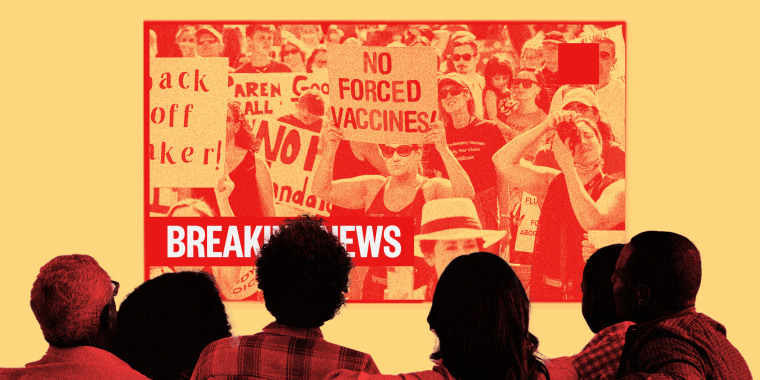It's been a rough couple of years to be a journalist, especially for those who work in local markets, where 2,100 newspapers have shut down since 2005. In 2020 alone, 16,000 journalists lost their jobs across the industry. At the same time, one bright spot has been local TV news stations, which have comparatively thrived. But they're going to have to do a lot better if they're going to be the vital information sources their communities need.
With that in mind, I say this with the greatest respect and admiration for local TV news reporters: You cannot keep letting yourselves get played, especially by the anti-vaccine movement.
Hopefully it isn't too shocking that I've always had a beef with the people who've screamed the loudest about the supposed dangers of vaccines. As hard as I try to understand them, their fears, what makes them think that their children's safety is more important than that of anyone else's children, I struggle. Especially when the desire to safeguard your children is being short-circuited as you leave them open to diseases that they wouldn't contract if you'd had them vaccinated. (I won't even get into the ableism at play in their misguided fear that vaccines cause autism.)
Thankfully, social media platforms where they've done the most harm lately, like Facebook and YouTube, are finally pushing back against their misinformation. Granted, it's mostly collateral damage — the platforms are specifically going after conspiracy theories about the Covid-19 vaccine as it's being rolled out around the U.S. Others have gotten rolled up because of their ties to the QAnon mass delusion, which has found a welcome home in the anti-vaccine movement. Still, I'm not about to look a gift horse in the mouth.
But NBC News' Brandy Zadrozny reported Thursday that the movement has figured out a different avenue to audiences: local TV news coverage. By logging off and holding good, old-fashioned demonstrations, complete with large handmade signs, it has learned how to entice news outlets to amplify its message.
"From California to Maine, local news stations that had largely stopped covering childhood immunization opponents have been highlighting the anti-vaccination movement's response to Covid-19 restrictions and solutions by covering their protests and giving activists a microphone to spread misinformation," Zadrozny wrote.
Journalists at all levels need to be willing to do their reporting, speak to experts and present their findings to the public — and given the freedom to shoot down lies and disinformation.
And at one level, I get the instinct to give airtime to these people and their rinky-dink protests. For one, not a lot is happening at the local level in a lot of places as the pandemic rages on — either your community has restrictions that are tamping down on a lot of the stories that interest your viewers or the spread is intense enough that there's not much else to cover. But now, here you have conflict, drama, passion — the elements of television worth watching.
On a less cynical level, too, I understand the desire to accurately reflect what's going on in your community. If people in your town have enough concerns about the Covid-19 vaccine to stand outside and protest, then surely their views deserve to be covered. It's a nice sentiment, but one that has major consequences.
There's been a lot of discussion about the role of the media at the national level as we move toward the post-Trump era and whether we should serve as "gatekeepers" for information. Ben Smith, the media columnist at The New York Times, raised the question when writing about The Wall Street Journal's decision not to publish materials meant to smear Joe Biden's son Hunter. During the rise of digital media outlets like BuzzFeed — where Smith was once my boss' boss — the instinct was often to publish what's out there, whether or not the old-school gatekeepers at the print giants like The Times approved. It was a more radical version of traditional publications' instincts to offer up both sides of an issue, trusting that informed readers would come to their own conclusions.
After four years of constant lies from President Donald Trump and his hangers-on, the ascent of the QAnon movement and a general poisoning of the digital well with targeted disinformation, neither feels like a winning model anymore. I'm glad that the "some issues don't have two sides" idea is so widespread now that it's almost a cliché — and that reporters are more skeptical and wary of sharing things bouncing around the internet than before.
Journalists at all levels need to be willing to do their reporting, speak to experts and present their findings to the public — and given the freedom to shoot down lies and disinformation. That's as true at The Wall Street Journal as it is at local TV stations, which, according to the Pew Research Center, is still the most common place for Americans to get their news.
Local reporters are in a position where their viewers are starved for dependable news that they can trust. They owe it to their communities to provide the fact checks nobody else can provide.

